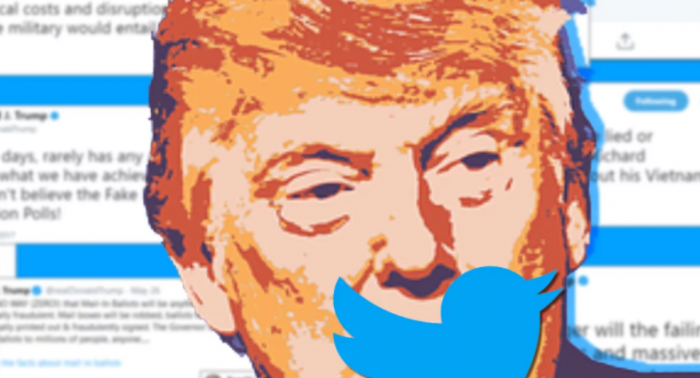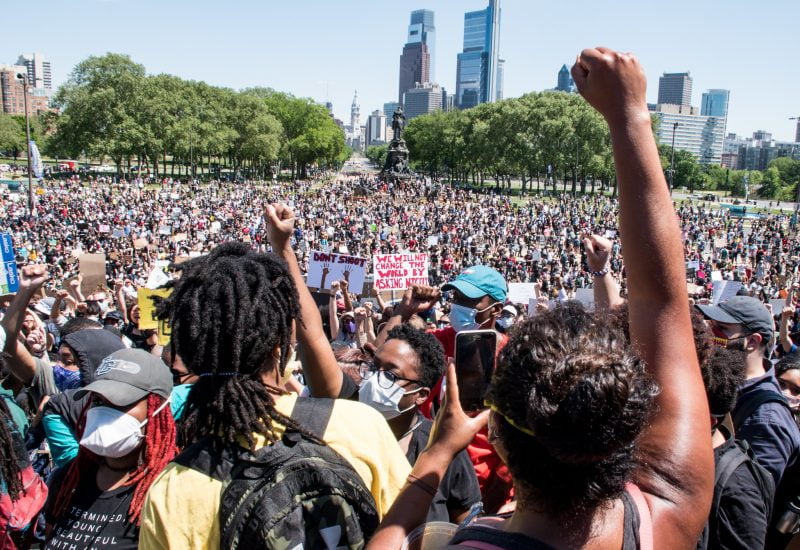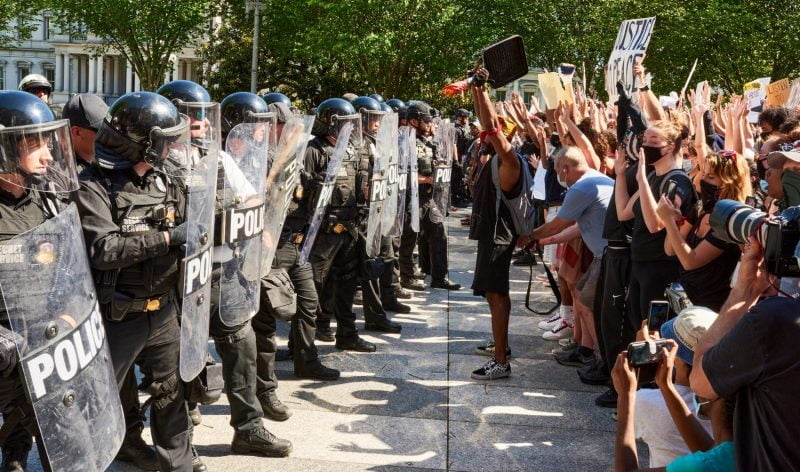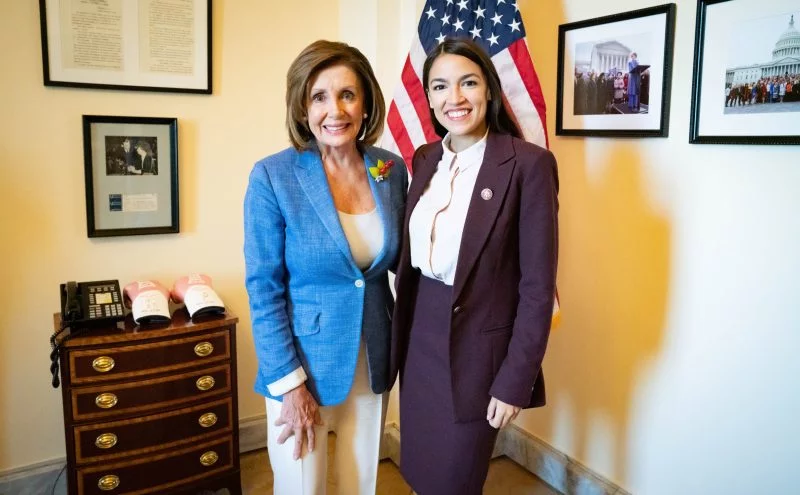
Two days after the riot on Capitol Hill, at the eleventh hour of the Trump administration, the CEOs of Twitter and Facebook took the unprecedented step of deactivating the accounts of the President of the United States. As the New York Times put it, “in the end, it was two California billionaires who pulled the plug on President Trump, [providing a] clarifying lesson in where power resides in our digital society.” A few days later, YouTube followed suit and suspended Trump’s account indefinitely.
These exceptional acts of censorship are particularly symbolic for a president who has spent the last four years disparaging the mass media and communicating with his base directly through Twitter. While many will doubtlessly revel in the irony and celebrate the silencing of the “Commander in Tweet,” socialists must consider the real consequences of these actions by Silicon Valley billionaires—and the implications for the class struggle.

Social media and polarization
In recent years, the liberals have blamed social media algorithms for “radicalizing” people and proliferating misinformation. However, as we have explained in previous articles, social media is not the cause of the intense polarization that has gripped society. The fact that a significant portion of the population has grown mistrustful of institutions like the media, the political establishment, and the federal government is not a result of the sequence of articles and posts showing up in their social media feeds. Rather, it is the underlying crisis of capitalism and the profound discontent it is generating for tens of millions that pushes them to reject the status quo. We should remember that polarization, revolution, and counterrevolution tore apart human societies long before the advent of the internet or social media.
There is a widespread sense that society has entered an impasse and has gone into terminal decline while a handful of elites enrich themselves at the expense of the vast majority—an accurate assessment and a healthy instinct! However, given the lack of a mass party of the working class, Trump has cynically tapped into this anti-establishment mood with his reactionary demagoguery, which is only reinforced by the scorn of the liberal politicians and the media. Far from undermining Trumpism, these constant attacks have only served to strengthen it, by convincing his base that “their” president is single-handedly defying the “powers that be.”
This is why Trumpism will not dissipate by pushing it off major social media and into more shadowy platforms. Facebook and Twitter have removed tens of thousands of far-right accounts. Amazon, Google, and others have taken similar steps. But as long as there are tens of millions with an internet connection and a fervent devotion to Donald Trump, they will find alternative ways of networking. Attempts at censorship fail completely to attack Trumpism at the roots.
Parler, an app that cultivated a user base among the most fringe reactionaries, has more than doubled to 10 million users since the November election. It has now been removed from Amazon’s web-hosting services and from the two main app stores which have a monopoly control. It is hemorrhaging advertisers and is finding it very difficult to purchase hosting. Similar apps and online forums have popped up to replace Twitter and Facebook, just as new streaming platforms have provided an alternative to YouTube, and “alternative news” websites like Newsmax and other “Trump Media” have replaced Fox News as the information source of choice for much of the Trump base.

The threat of “terrorism” and the threat to the labor movement
Socialists are opposed to the methods of capitalist censorship, not only because they are utterly ineffective at curbing the growth of the far right, but also because these methods pose a clear threat to the left and the broader working class as well. The precedent of blocking views deemed by the liberal billionaires to be “radical” and “extremist” will mean an even harder crackdown on Black Lives Matter activists, labor, and socialists in the future.
In fact, in the months following the historic George Floyd rebellion, and shortly after Trump pledged to designate “antifa” a domestic terrorist organization, Facebook systematically targeted and removed pages that had been posting videos and updates of protests and police violence. By September, Facebook announced that they had purged nearly 1,000 such groups and over 500 pages, in addition to restricting hashtags. Accounts like It’s Going Down, the CrimethInc Ex-Workers Collective, the Pacific Northwest Youth Liberation Front, and Enough is Enough, and many other activist, anarchist, and antifascist accounts were unceremoniously removed.
Simultaneously, hundreds of far-right pages and groups connected to the Q-Anon conspiracy were taken down, as part of a campaign that lumped together fascists and anti-fascists, with the claim that they both had “followers with patterns of violent behavior.” Reminiscent of Trump’s “blame both sides” response to the 2018 far-right rally in Charlottesville, this attitude equates anarchists and socialists with racists and neo-Nazis, condemning them all as “violent extremists.” Nevermind that the far right is responsible for the vast majority of incidents of political violence and terror in the US.

After Joe Biden referred to the Capitol mob as “domestic terrorists,” Democrats, including self-styled socialists, are pushing for the classification of the January 6 events as a domestic terrorist act, in order to come after those involved more stringently, and to implicate Trump himself for his role in instigating it. They are under the illusion that the power of the state can stamp out Trumpism forever.
Again, we only have to look back to the the mass movement in 2020 to see how the state can cynically wield the “terrorism” in any direction the ruling class wishes. BLM activists and demonstrators were charged with terrorism and outlandish jail sentences for organizing and participating in peaceful rallies. And after the September 11 attacks and the Patriot Act, championed by Biden, innocent Muslims and their organizations were accused of terrorism and subjected to state surveillance and intimidation. Meanwhile, far-right extremists rarely faced similar consequences for blatantly racist acts of mass murder such as the shooting in Charleston.
While Biden has promised to take action against “domestic extremists,” the images of police officers letting protesters onto Capitol grounds and of off-duty cops participating in the mob itself hardly inspire confidence in the capitalist state’s ability to take action against these elements. Among the ranks of Washington DC law enforcement were those who beat, tear-gassed, and jailed protestors last summer—protestors who did not kill anyone or assault the Capitol.
It is clear that the Democrats in power will use the storming of the Capitol by a reactionary mob as an excuse to pass new legislation against “domestic terrorism,” giving the capitalist state and its security forces additional powers of surveillance and curtailing basic democratic rights. There is precedent for this. After the 2001 September 11 terrorist attacks, the Bush administration brought in the Homeland Security Act, which opened the way for mass surveillance of private individuals who had committed no crime. The Department of Homeland Security, under the excuse of making the country safe from terrorism, has been used to monitor and clamp down on the activities of anti-war activists and more recently against Black Lives Matter activists.

The capitalist class owns and controls the media
Even though the airwaves are “free,” capitalism has turned this into private property. From the big networks, cable TV systems, and radio stations, to Big Tech monopolies like Google, Twitter, and Facebook, the media in all its forms is firmly in the hands of the capitalist class. In their banning of Trump, the question of who owns and controls the media is now front and center for all to see.
The rise of capitalism was characterized by increasingly social production coupled with private appropriation of the surplus wealth created by the working class. The recent history of social media brings this contradiction to a new level. Never before has humanity been so globally connected—it is estimated that at least half of the world’s population has a social media account—and yet, these incredibly social platforms remain privately owned and controlled.
Despite their ubiquity in daily life, the big tech companies are capitalist enterprises, driven by profits and accountable only to their shareholders. Since they are privately owned companies, users of social media are not protected by first amendment rights. In fact, quite the opposite! The Constitution, a document which defends private property of the means of production above all else, protects the free-speech rights of businesses, as well as their right not to be associated with the speech of certain users if they prefer not to—even if the user in question is the President himself.
In the era of “fake news” this also means that Silicon Valley capitalists have become the all-powerful and unaccountable judges who determine what constitutes “misinformation”—including political outlooks that challenge capitalism, or those critical of the foreign policy fairy tales of US imperialism. In recent years, thousands of Twitter accounts supporting the Venezuelan government have been suspended without warning, including numerous accounts of government officials. Last January, Twitter also suspended the account of the comrades of the IMT in Venezuela, Lucha de Clases, who had been putting forward a consistent socialist program for expropriation of key industries and workers’ democracy.

It is not hard to see the implications of this pattern for the future battles of the class struggle. Today it is Trump and his reactionary supporters who are being “de-platformed”—not because of the demands or pressure of the working class, but because Trump has come to be perceived as an intolerable threat to the stability of the system and its institutions. But tomorrow, Silicon Valley billionaires could just as easily decide to eliminate the accounts of striking workers, activists coordinating protests, or pages that provide news and information about the movements of the working class internationally.
As the class struggle intensifies, the broad label of “misinformation” can and will be used against revolutionary socialist ideas as well. In fact, activists have reported the suppression of social media posts condemning the capitalist system for the devastation of the COVID-19 crisis, on the grounds that this view constituted fake news!
For genuine freedom of expression and a democratized media!
The hypocritical bourgeois myth of “free speech” rings especially hollow in a media system so overtly monopolized by a handful of billionaires. For the capitalist class, “free speech” is held up as an eternal and abstract principle, in reality a facade to hide the dictatorship of the ruling class behind a smoke screen of “objectivity” and “democratic” values.
Marxists are in favor of genuine freedom of expression, which, like all basic democratic rights, must be fought for through class struggle. This does not mean, however, that we are in favor of fascists being able to freely organize and put forward their views. But whose responsibility is it to shut down this human garbage? Big business? The capitalist state? These entities cannot be relied on to nip this poison in the bud. On the contrary, history shows that, far from curbing the far right, the capitalists will use reactionary groups as a battering ram against the working class. As a last resort, in the context of an existential threat to their system and the serious defeat of a revolutionary fight for power, the ruling class will always favor a military dictatorship in some form over handing power to the working class.
In an article about the situation in Mexico in 1938, Trotsky wrote about the question of the fight against the reactionary press and warned that this question could not be handled by demanding the intervention of the capitalist state, as any such powers would then be used against the workers’ organizations:
It is essential to wage an unrelenting battle against the reactionary press. But the workers cannot leave a task they have to fulfill themselves through their own organizations and their own press, to the repressive fist of the bourgeois state. Today the government may seem well disposed towards workers’ organizations. Tomorrow it may fall, and it inevitably will, into the hands of the most reactionary elements of the bourgeoisie. In this case the existing repressive laws will be used against the workers. Only adventurists who think of nothing but the moment’s needs can fail to guard themselves against such a danger. The most efficient way to fight the bourgeois press is for the workers’ press to develop. (Leon Trotsky, Freedom of the Press and the Working Class, August 1938)
We propose class methods to fight the far right: mass, working-class mobilizations to counter far-right rallies and prevent them from spewing their poison. Instead of the bourgeois state, and selective “war on terror” laws, we propose workers’ self-defense against the violence of the right and the state terror of racist police. The embryonic examples of neighborhood patrols such as those that developed organically last summer in Minneapolis could have been extended into every city and coordinated democratically by the ranks of the labor movement. The workers at the tech companies, such as those at Google who have begun to unionize, can take matters into their own hands to shut down the far right, without appealing to the bosses.

Ultimately, Amazon, Google, Twitter, Facebook, and other related services must be nationalized and placed under the democratic control of the working-class majority. Under a workers’ government, there would be much more diversity in the media than exists under capitalist censorship. The whims of profits and advertising are a poor way to serve the indispensable social needs they fulfill, or decide who has access to them. Under a workers’ government, society will be able to decide democratically how to allot access to the media, and how to handle violent, reactionary propaganda. Only in this way can “freedom of speech” be more than the hypocritical, empty phrase we know now, but fulfilled in real life.
This was clearly explained in the 1919 program of the Russian Communist Party, just after the workers took power:
Bourgeois democracy confined itself to the formal extension of political rights and liberties, such as the right of assembly, right of association, and freedom of the press, to all citizens alike. But in reality, administrative practice, and above all the economic enslavement of the toilers under bourgeois democracy, has always rendered it impossible for the toilers to make any wide use of these rights and liberties.
On the contrary, proletarian democracy, instead of formally claiming rights and liberties, actually grants them primarily and mainly to those classes of the population which have been oppressed by capitalism, namely the proletariat and the peasantry. For this purpose the Soviet government expropriates the bourgeoisie from buildings, printing plants, paper stores, etc., and places them at the complete disposal of the workers and of their organizations.
The task of the Communist Party of the Soviet Union is to draw ever wider masses of the toiling population into the enjoyment of democratic rights and liberties and to widen the material possibilities for this.
Today’s “printing plants and paper stores” are the web servers, social media platforms, and apps, but the basic ideas in this program remain valid.

Fight Trumpism with class struggle not bourgeois censorship and legalism!
The simmering discontent in society, ultimately a consequence of the historical exhaustion of the capitalist system, is fueling polarization to both the right and the left. While the liberals and the media mouthpieces of the bourgeois establishment decry the collapse of the “moderate center” and the end of political “civility” and bipartisan consensus, we explain that the same process is driving many more people to socialism, with the young generation of workers in the front ranks.
At the same time, the lack of a visible, class-independent, left-wing opposition to the status quo temporarily gives the right wing a disproportionate echo as a point of attraction for the anger in society. This situation can be summed up as a crisis of working-class leadership.
The urgent task of socialists is to combat this vacuum in two ways. The first is to demand an immediate and unequivocal break with the Democratic Party, which more clearly than ever represents the party of Wall Street and is inherently incapable of serving as a vehicle of the working-class struggle against Trumpism. The strategy of running “socialist” candidates on the Democratic Party ballot line, only to watch them capitulate to the establishment one by one, has clearly and utterly failed. The way forward is to fight against both parties of the capitalist class by working with organized labor to build a mass socialist party, starting with running independent socialist candidates in major cities.

The second and equally indispensable element in the fight against Trumpism, is that such a party must be armed with a bold program of revolutionary policies that address the burning needs of the workers on a class basis. This is the only way to undermine the unholy alliance of a significant portion of the working class with Trump and his sycophants in the Republican Party. These reactionaries have cynically presented themselves as anti-elitist “friends of the worker”—in contrast to the corporate-backed Democrats.
Socialists must cut through the rhetoric of both parties and patiently and systematically make the case for the nationalization of the largest banks and monopolies in order to dramatically raise the living standards of the working class. By bringing the Fortune 500 under the democratic control of the working class and consciously planning the economy, we could guarantee a $1,000/week minimum wage, eliminate homelessness, resolve the housing, health, and student debt crises, hack at the roots of inequality and oppression, and take transformative measures to tackle the climate crisis while protecting workers’ livelihoods.
Rather than celebrate the digital de-platforming of Trump and his followers from mainstream social media—however reactionary those elements may be—socialists must explain that the capitalist class and its institutions are no defense against the menace of the far right. Only the organized working class can mount a successful struggle against this threat.

